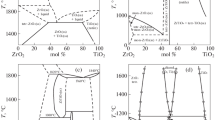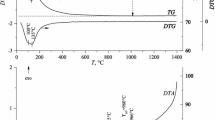Abstract
Zirconium oxide is one of the most promising ceramic materials as it finds applications in several high-level technological fields, ranging from biomedicine to sensing. Zirconium oxide is characterized by showing very uncommon properties for being a ceramic substrate, such as a certain plastic behavior once subjected to mechanical stress, a naturally occurring phase transformation toughening, as well as a dramatic sensibility toward water-induced aging (if hydrothermally treated). In general, all these properties are strictly correlated with the tetragonal-to-monoclinic interphase transformation and, consequently, driven by the stabilization of the tetragonal phase. Hence, in this study, a summary of the main relevant principles guiding zirconium oxide interphase transformations is proposed, highlighting the important role of stabilizers and the correlation between microstructure and doping. A particular emphasis has been dedicated to the thermodynamics behind these phenomena.










Similar content being viewed by others
Data availability
Data sharing not applicable—no new data generated.
References
Iranmanesh, M., Hulliger, J.: Ceramic combinatorial syntheses exploring the chemical diversity of metal oxides. Prog. Solid State Chem. 44, 123–130 (2016). https://doi.org/10.1016/j.progsolidstchem.2016.11.003
Chevalier, J., Gremillard, L.: 1.106 – Zirconia as a biomaterial. In: Ducheyne, P. (ed.) Comprehensive biomaterials, pp. 95–108. Elsevier, Oxford (2011). https://doi.org/10.1016/B978-0-08-055294-1.00017-9
Wang, G., Yang, Y., Han, D., Li, Y.: Oxygen defective metal oxides for energy conversion and storage. NanoToday. 13, 23–39 (2017). https://doi.org/10.1016/j.nantod.2017.02.009
Sk, M.M., Yue, C.Y., Ghosh, K., Jena, R.K.: Review on advances in porous nanostructured nickel oxides and their composite electrodes for high-performance supercapacitors. J. Power Sources. 308, 121–140 (2016). https://doi.org/10.1016/j.jpowsour.2016.01.056
Nisticò, R.: Magnetic materials and water treatments for a sustainable future. Res. Chem. Intermed. 43, 6911–6949 (2017). https://doi.org/10.1007/s11164-017-3029-x
Palma, D., Bianco Prevot, A., Brigante, M., Fabbri, D., Magnacca, G., Richard, C., Mailhot, G., Nisticò, R.: New insights on the photodegradation of caffeine in the presence of bio-based substances-magnetic iron oxide hybrid nanomaterials. Materials. 11, 1084 (2018). https://doi.org/10.3390/ma11071084
Dey, A.: Semiconductor metal oxide gas sensors: a review. Mater. Sci. Eng. B. 229, 206–217 (2018). https://doi.org/10.1016/j.mseb.2017.12.036
Nisticò, R., Scalarone, D., Magnacca, G.: Sol-gel chemistry, templating and spin-coating deposition: a combined approach to control in a simple way the porosity of inorganic thin films/coatings. Microporous Mesoporous Mater. 248, 18–29 (2017). https://doi.org/10.1016/j.micromeso.2017.04.017
Ishak, N.F., Hashim, N.A., Othman, M.H.D., Monash, P., Zuki, F.M.: Recent progress in the hydrophilic modification of alumina membranes for protein separation and purification. Ceram. Int. 43, 915–925 (2017). https://doi.org/10.1016/j.ceramint.2016.10.044
Castano, C.E., O’Keefe, M.J., Fahrenholtz, W.G.: Cerium-based oxide coatings. Curr. Opin. Solid State Mater. Sci. 19, 69–76 (2015). https://doi.org/10.1016/j.cossms.2014.11.005
Piconi, C., Porporati, A.A.: Bioinert ceramics: zirconia and alumina. In: Antoniac, I. (ed.) Handbook of Bioceramics and Biocomposites, pp. 59–89. Springer, Cham (2016). https://doi.org/10.1007/978-3-319-12460-5_4
Fletcher, L.: The occurrence of native zirconia (baddeleyite). Nature. 47, 283–284 (1893). https://doi.org/10.1038/047283b0
Lumpkin, G.R.: Physical and chemical characteristics of baddeleyite (monoclinic zirconia) in natural environments: an overview and case study. J. Nucl. Mater. 274, 206–217 (1999). https://doi.org/10.1016/S0022-3115(99)00066-5
Piconi, C., Maccauro, G.: Zirconia as a ceramic biomaterial. Biomaterials. 20, 1–25 (1999). https://doi.org/10.1016/S0142-9612(98)00010-6
Guo, X., Waser, R.: Electrical properties of the grain boundaries of oxygen ion conductors: acceptor-doped zirconia and ceria. Prog. Mater. Sci. 51, 151–210 (2006). https://doi.org/10.1016/j.pmatsci.2005.07.001
Rahmati, M., Mozafari, M.: A critical review on the cellular and molecular interactions at the interface of zirconia-based biomaterials. Ceram. Int. 44, 16137–16149 (2018). https://doi.org/10.1016/j.ceramint.2018.06.196
Kelly, J.R., Denry, I.: Stabilized zirconia as a structural ceramic: an overview. Dent. Mater. 24, 289–298 (2008). https://doi.org/10.1016/j.dental.2007.05.005
Roza, G.: Understanding the elements of periodic table, Zirconium. Rosen Publishing Group Inc., New York (2009) ISBN: 978-1435850705
Chevalier, J.: What future for zirconia as a biomaterial? Biomaterials. 27, 535–543 (2006). https://doi.org/10.1016/j.biomaterials.2005.07.034
Turon-Vinas, M., Anglada, M.: Strength and fracture toughness of zirconia dental ceramics. Dent. Mater. 34, 365–375 (2018). https://doi.org/10.1016/j.dental.2017.12.007
Garvie, R.C., Hannink, R.H., Pascoe, R.T.: Ceramic steel? Nature. 258, 703–704 (1975). https://doi.org/10.1038/258703a0
Brog, J.P., Chanez, C.L., Crochet, A., Fromm, K.M.: Polymorphism, what it is and how to identify it: a systematic review. RSC Adv. 3, 16905–16931 (2013). https://doi.org/10.1039/C3RA41559G
Hannink, R.H.J., Kelly, P.M., Muddle, B.C.: Transformation toughening in zirconia-containing ceramics. J. Am. Ceram. Soc. 83, 461–487 (2000). https://doi.org/10.1111/j.1151-2916.2000.tb01221.x
Chevalier, J., Gremillard, L., Virkar, A.V., Clarke, D.R.: The tetragonal-monoclinic transformation in zirconia: lessons learned and future trends. J. Am. Ceram. Soc. 92, 1901–1920 (2009). https://doi.org/10.1111/j.1551-2916.2009.03278.x
Li, P., Chen, I.W., Penner-Hahn, J.E.: Effect of dopants on zirconia stabilization—an X-ray absorption study: I, trivalent dopants. J. Am. Ceram. Soc. 77, 118–128 (1994). https://doi.org/10.1111/j.1151-2916.1994.tb06964.x
Li, P., Chen, I.W., Penner-Hahn, J.E.: Effect of dopants on zirconia stabilization—an X-ray absorption study: II, tetravalent dopants. J. Am. Ceram. Soc. 77, 1281–1288 (1994). https://doi.org/10.1111/j.1151-2916.1994.tb05403.x
Kohorst, P., Borchers, L., Strempel, J., Stiesch, M., Hessel, T., Bach, F.-W., Hubsch, C.: Low-temperature degradation of different zirconia ceramics for dental applications. Acta Biomater. 8, 1213–1220 (2012). https://doi.org/10.1016/j.actbio.2011.11.016
Sulaiman, T.A., Abdulmajeed, A.A., Donovan, T.E., Vallittu, P.K., Narhi, T.O., Lassila, L.V.: The effect of staining and vacuum sintering on optical and mechanical properties of partially and fully stabilized monolithic zirconia. Dent. Mater. J. 34, 605–610 (2015). https://doi.org/10.4012/dmj.2015-054
Gautam, C., Joyner, J., Gautam, A., Rao, J., Vajtai, R.: Zirconia based dental ceramics: structure, mechanical properties, biocompatibility and applications. Dalton Trans. 45, 19194–19215 (2016). https://doi.org/10.1039/C6DT03484E
de Bernardi-Martin, S., Moshtaghioun, B.M., Gomez Garcia, D., Dominguez-Rodrigues, A.: Grain-boundary cation diffusion in ceria tetragonal zirconia determined by constant-strain-rate deformation tests. J. Eur. Ceram. Soc. 34, 4469–4472 (2014). https://doi.org/10.1016/j.jeurceramsoc.2014.06.024
Lughi, V., Sergo, V.: Low temperature degradation – aging – of zirconia: a critical review of the relevant aspects in dentistry. Dent. Mater. 26, 807–820 (2010). https://doi.org/10.1016/j.dental.2010.04.006
Dynacer.com. Data sheets Zirconia. http://www.dynacer.com/wp-content/themes/devvine/PDF/Material%20Properties%20datasheet.pdf (2018). Accessed 11 September 2018
Azom.com. Zirconia - physical and mechanical property comparison of the different types of zirconias. https://www.azom.com/article.aspx?ArticleID=940 (2018). Accessed 11 September 2018
Tsukuma, K., Shimada, M.: Strength, fracture toughness and Vickers hardness of CeO2-stabilized tetragonal ZrO2 polycrystals (Ce-TZP). J. Mater. Sci. 20, 1178–1184 (1985). https://doi.org/10.1007/BF01026311
Cousland, G.P., Cui, X.Y., Smith, A.E., Stampfl, A.P.J., Stampfl, C.M.: Mechanical properties of zirconia, doped and undoped yttria-stabilized cubic zirconia from first-principles. J. Phys. Chem. Solids. 122, 51–71 (2018). https://doi.org/10.1016/j.jpcs.2018.06.003
Eichler, J., Eisele, U., Rodel, J.: Mechanical properties of monoclinic zirconia. J. Am. Ceram. Soc. 87, 1401–1403 (2004). https://doi.org/10.1111/j.1151-2916.2004.tb07748.x
Kuo, C.-W., Shen, Y.-H., Yen, F.-L., Cheng, H.-Z., Hung, I.-M., Wen, S.-B., Wang, M.-C., Stack, M.: Phase transformation behavior of 3 mol% yttria partially-stabilized ZrO2 (3Y–PSZ) precursor powder by an isothermal method. Ceram. Int. 40, 3243–3251 (2014). https://doi.org/10.1016/j.ceramint.2013.09.112
Li, P., Chen, I.W., Penner-Hahn, J.E.: Effect of dopants on zirconia stabilization—an X-ray absorption study: III, charge-compensating dopants. J. Am. Ceram. Soc. 77, 1289–1295 (1994). https://doi.org/10.1111/j.1151-2916.1994.tb05404.x
Schnohr, C.S., Ridgway, M.C.: Chapter 1, introduction to X-ray absorption spectroscopy. In: Schnohr, C.S., Ridgway, M.C. (eds.) X-Ray absorption spectroscopy of semiconductors, Springer Series in Optical Sciences 190, pp. 1–26. Springer, Cham (2015). DOI https://doi.org/10.1007/978-3-662-44362-0_1
Escribano, V.S., Lopez, E.F., Panizza, M., Resini, C., Gallardo Amores, J.M., Busca, G.: Characterization of cubic ceria–zirconia powders by X-ray diffraction and vibrational and electronic spectroscopy. Solid State Sci. 5, 1369–1376 (2003). https://doi.org/10.1016/j.solidstatesciences.2003.07.001
Varez, A., Garcia-Gonzalez, E., Sanz, J.: Cation miscibility in CeO2–ZrO2 oxides with fluorite structure. A combined TEM, SAED and XRD Rietveld analysis. J. Mater. Chem. 16, 4249–4256 (2006). https://doi.org/10.1039/B607778A
Chevalier, J., Gremillard, L.: Ceramics for medical applications: a picture for the next 20 years. J. Eur. Ceram. Soc. 29, 1245–1255 (2009). https://doi.org/10.1016/j.jeurceramsoc.2008.08.025
Becher, P.F., Swain, M.V.: Grain-size-dependent transformation behavior in polycrystalline tetragonal zirconia. J. Am. Ceram. Soc. 75, 493–502 (1992). https://doi.org/10.1111/j.1151-2916.1992.tb07832.x
Simba, B.G., dos Santos, C., Strecker, K., de Almeida Junior, A.A., Adabo, C.L.: Recovery of tetragonal phase from previously transformed Y-TZP. Mater. Res. 19, 829–833 (2016). https://doi.org/10.1590/1980-5373-MR-2015-0426
Lange, F.F.: Transformation toughening. Part 1 size effects associated with the thermodynamics of constrained transformations. J. Mater. Sci. 17, 225–234 (1982). https://doi.org/10.1007/BF00809057
De Aza, A.H., Chevalier, J., Fantozzi, G., Schehl, M., Torrecillas, R.: Slow-crack-growth behavior of zirconia-toughened alumina ceramics processed by different methods. J. Am. Ceram. Soc. 86, 115–120 (2003). https://doi.org/10.1111/j.1151-2916.2003.tb03287.x
Tsukuma, K., Takahata, T.: Mechanical properties and microstructure of TZP and TZP/Al2O3 composites. Mater. Res. Soc. Symp. Proc. 78, 123–135 (1986). https://doi.org/10.1557/PROC-78-123
Bannister, M.: Science and Technology of Zirconia V. CRC Press, Boca Raton (1993) ISBN: 9781566760737
Yu, C.S., Shetty, D.K.: Transformation zone shape, size, and crack-growth-resistance [R-curve] behavior of ceria-partially-stabilized zirconia polycrystals. J. Am. Ceram. Soc. 72, 921–928 (1989). https://doi.org/10.1111/j.1151-2916.1989.tb06245.x
Swain, M.V., Rose, L.R.F.: Strength limitations of transformation-toughened zirconia alloys. J. Am. Ceram. Soc. 69, 511–518 (1986). https://doi.org/10.1111/j.1151-2916.1986.tb04785.x
Studart, A.R., Filser, F., Kocher, P., Gauckler, L.J.: Fatigue of zirconia under cyclic loading in water and its implications for the design of dental bridges. Dent. Mater. 23, 106–114 (2007). https://doi.org/10.1016/j.dental.2005.12.008
Li, L.-S., Pabst, R.F.: Subcritical crack growth in partially stabilized zirconia (PSZ). J. Mater. Sci. 15, 2861–2866 (1980). https://doi.org/10.1007/BF00550555
Szutkowska, M., Boniecki, M.: Subcritical crack growth in zirconia-toughened alumina (ZTA) ceramics. J. Mater. Process. Technol. 175, 416–420 (2006). https://doi.org/10.1016/j.jmatprotec.2005.04.030
Schmitt, R., Fett, T., Munz, D.: Cyclic fatigue of zirconia. Fatigue Fract. Eng. Mater. Struct. 19, 1411–1420 (1996). https://doi.org/10.1111/j.1460-2695.1996.tb00177.x
Zmak, I., Coric, D., Mandic, V., Cirkovic, L.: Hardness and indentation fracture toughening of slip cast alumina and alumina-zirconia ceramics. Materials. 13, 122 (2020). https://doi.org/10.3390/ma13010122
Marshall, D.B., Evans, A.G., Drory, M.: Transformation toughening in ceramics. In: Bradt, R.C., Evans, A.G., Hasselman, D.P.H., Lange, F.F. (eds.) Fracture Mechanics of Ceramics, vol. 6, pp. 289–307. Plenum Press, New York (1983) ISBN: 0306410222
Bocanegra-Bernal, M.H., Garcia-Reyes, A., Dominguez-Rios, C., Reyes-Rojas, A., Aguilar-Elguezabal, A., Echeberria, J.: Towards improving low-temperature degradation of zirconia/alumina ceramics via in situ formation of an Al2O3 functional surface layer through sintering in the presence of graphite powder. J. Alloys Compd. 818, 152840 (2020). https://doi.org/10.1016/j.jallcom.2019.152840
AllThingsBiomaterials.org. The Prozyr Femoral Ball Re-call. http://allthingsbiomaterials.org/archives/170 (2020). Accessed 19 January 2020
Lawson, S.: Environmental degradation of zirconia ceramics. J. Eur. Ceram. Soc. 15, 485–502 (1995). https://doi.org/10.1016/0955-2219(95)00035-S
Sergo, V., Pompe, W., Clarke, D.R.: Deformation bands in ceria-stabilized tetragonal zirconia/alumina: I. Measurement of internal stresses. J. Am. Ceram. Soc. 78, 633–640 (1995). https://doi.org/10.1111/j.1151-2916.1995.tb08224.x
Lange, F.F., Dunlpo, G.L., Davis, B.I.: Degradation during ageing of transformation toughened ZrO2-Y2O3 materials at 250 °C. J. Am. Ceram. Soc. 69, 237–240 (1986). https://doi.org/10.1111/j.1151-2916.1986.tb07415.x
Yoshimura, M., Noma, T., Kawabata, K., Somiya, S.: Role of H2O on the degradation process of Y-TZP. J. Mater. Sci. Lett. 6, 465–467 (1987). https://doi.org/10.1007/BF01756800
Deville, S., Chevalier, J., Dauvergne, C., Fantozzi, G., Bartolomé, J.F., Moya, J.S., Torrecillas, R.: Microstructural investigation of the aging behavior of (3Y-TZP)-Al2O3 composites. J. Am. Ceram. Soc. 88, 1273–1280 (2005). https://doi.org/10.1111/j.1551-2916.2005.00221.x
Lee, J.K., Kim, H.: Surface crack initiation in 2Y-TZP ceramics by low temperature aging. Ceram. Int. 20, 413–418 (1994). https://doi.org/10.1016/0272-8842(94)90028-0
Patil, N.A., Kandasubramanian, B.: Biological and mechanical enhancement of zirconium dioxide for medical applications. Ceram. Int. 46, 4041–4057 (2020). https://doi.org/10.1016/j.ceramint.2019.10.220
Kelly, P.M., Rose, L.R.F.: The martensitic transformation in ceramics – its role in transformation toughening. Prog. Mater. Sci. 47, 463–557 (2002). https://doi.org/10.1016/S0079-6425(00)00005-0
Varghese, G., Moral, M., Castro-Garcia, M., Lopez-Lopez, J.J., Marin-Rueda, J.R., Yague-Alcaraz, V., Hernandez-Afonso, L., Ruiz-Morales, J.C., Canales-Vazquez, J.: Fabrication and characterization of ceramics via low-cost DLP 3D printing. Bol. Soc. Esp. Cerám. Vidrio. 57, 9–18 (2018). https://doi.org/10.1016/j.bsecv.2017.09.004
Zhu, W., Nakashima, S., Matsuura, M., Gu, H., Marin, E., Pezzotti, G.: Raman and X-ray photoelectron spectroscopic characterizations of thermal stability of 3mol% yttria stabilized zirconia ceramics. J. Eur. Ceram. Soc. 39, 4928–4935 (2019). https://doi.org/10.1016/j.jeurceramsoc.2019.06.056
Schunemann, F.H., Galarraga-Vinueza, M.E., Magini, R., Fredel, M., Silva, F., Souza, J.C.M., Zhang, Y., Herniques, B.: Zirconia surface modifications for implants dentistry. Mater. Sci. Eng. C. 98, 1294–1305 (2019). https://doi.org/10.1016/j.msec.2019.01.062
Berni, M., Lopomo, N., Marchiori, G., Gambardella, A., Boi, M., Bianchi, M., Visani, A., Pavan, P., Russo, A., Marcacci, M.: Tribological characterization of zirconia coatings deposited on Ti6Al4V components for orthopedic applications. Mater. Sci. Eng. C. 62, 643–655 (2016). https://doi.org/10.1016/j.msec.2016.02.014
Moos, R.: A brief overview on automotive exhaust gas sensors based on electroceramics. Int. J. Appl. Ceram. Technol. 2, 401–413 (2005). https://doi.org/10.1111/j.1744-7402.2005.02041.x
Author information
Authors and Affiliations
Ethics declarations
Declarations
Not applicable.
Conflict of interest
The authors declare that they have no conflict of interest.
Additional information
Publisher’s note
Springer Nature remains neutral with regard to jurisdictional claims in published maps and institutional affiliations.
Rights and permissions
About this article
Cite this article
Nisticò, R. Zirconium oxide and the crystallinity hallows. J Aust Ceram Soc 57, 225–236 (2021). https://doi.org/10.1007/s41779-020-00529-2
Received:
Revised:
Accepted:
Published:
Issue Date:
DOI: https://doi.org/10.1007/s41779-020-00529-2




